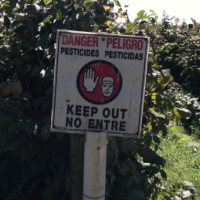Study Links Autism to Pesticides in Central Valley, Again
 (photo: Tomás Madrigal)
(photo: Tomás Madrigal)
One of the following two sentences appeared in Monday’s Los Angeles Times and the other in the July 30, 2007, edition of the newspaper. Which is which?
Quote 1: “Women who live near California farm fields sprayed with organochlorine pesticides may be more likely to give birth to children with autism, according to a study by state health officials to be published today.”
Quote 2: “Pregnant women in California who live close to areas where chemical pesticides are used are more likely to have a child with autism, says a study released by UC Davis researchers Monday.”
Both stories described large studies in the Central Valley that showed a much higher incidence of autism, but the story from which the first quote is drawn stressed that the 2007 findings were “highly preliminary” because there was no scientific explanation yet for the connection with pesticides and other than an Italian study in 2005, this was the first to make a statistical one.
Seven years later, a new study from the MIND Institute at the University of California, Davis “strengthens the evidence linking neurodevelopmental disorders with gestational pesticide exposures.”
That’s progress that might not be fully appreciated by pregnant women living within one mile of farms and other sites that use pesticides who, as it turns out, are 60% more likely to deliver a child with autism spectrum disorder or other developmental problems. The study, published in the journal Environmental Health Perspectives, says women in their second or third trimester appeared to be at even higher risk.
“The message is very clear: Women who are pregnant should take special care to avoid contact with agricultural chemicals whenever possible,” the study’s lead author, Janie F. Shelton, said in a prepared statement.
That certainly might be one message. Shelton suggested another to the Times that takes into consideration chemical effects on the nervous system of pregnant women because, “It is not a requirement of getting a pesticide approved. Instead of putting the onus entirely on women thinking of getting pregnant, I think the public should consider that regulators require this kind of testing.”
The researchers compared data from 970 mothers in the Childhood Risk of Autism from Genetics and the Environment (CHARGE) study, the majority of which lived within two hours of Sacramento, with the California Pesticide Use Report. The study included the range of conditions in the autism spectral disorder (ASD), including Asperger syndrome and more pronounced forms of behavior.
Around one-third of the participants lived between three-quarters of a mile and one mile from pesticide applications.
Four different pesticide groups were included. The organophosphate class was the most prominent, led by chlorpyrifos, the most commonly used pesticide in the study. It had the greatest relationship to autism disorders in the second trimester. Pesticides in the second-most popular class, pyrethroids, had strong links to autism disorder in the first and third trimester. The synthetic chemicals are already linked to farmworker respiratory ailments, heart palpitations and nausea.
California is the nation’s number one agricultural producer. The farm industry grossed $38 billion in 2010 and uses 200 million pounds of pesticides a year to help make it happen. An industry that has found the wherewithal to use 80% of the state’s water growing food in desert-like conditions and employ migrant labor under brutal conditions will not readily abandon pesticides.
CHARGE principal investigator Irva Hertz-Picciotto, professor and vice chair of the Department of Public Health Sciences at UC Davis, said, “If it were my family, I wouldn't want to live close to where heavy pesticides are being applied.”
Failing that, she said it is important to reduce the exposure of people to pesticides, especially the young. Nearly a decade after links between pesticides and autism were established, and even longer since people knew pesticides were a health problem in general, Hertz-Picciotto said, “We need to open up a dialogue about how this can be done, at both a societal and individual level.”
Or not.
–Ken Broder
To Learn More:
Offspring Autism Risk Linked to Pesticide Exposure During Pregnancy (by Honor Whiteman, Medical News Today)
Pesticide Exposure During Pregnancy Linked to Higher Autism Risk (by Javier Panzar, Los Angeles Times)
Pregnant Women Living near Where Agricultural Pesticides Are Applied at Greater Risk for a Child with Autism, UC Davis Study Says (by Edward Ortiz, Sacramento Bee)
UC Davis MIND Institute Study Finds Association between Maternal Exposure to Agricultural Pesticides, Autism in Offspring (UC Davis Health System)
- Top Stories
- Controversies
- Where is the Money Going?
- California and the Nation
- Appointments and Resignations
- Unusual News
- Latest News
- California Forbids U.S. Immigration Agents from Pretending to be Police
- California Lawmakers Urged to Strip “Self-Dealing” Tax Board of Its Duties
- Big Oil’s Grip on California
- Santa Cruz Police See Homeland Security Betrayal in Use of Gang Roundup as Cover for Immigration Raid
- Oil Companies Face Deadline to Stop Polluting California Groundwater





